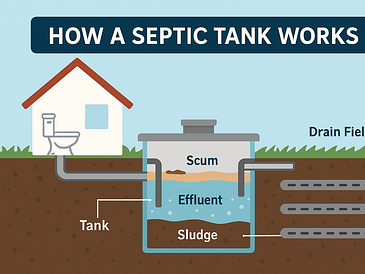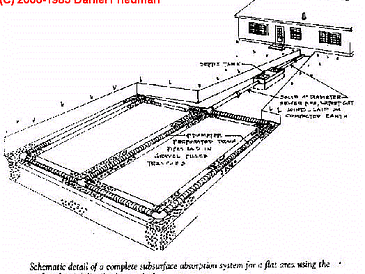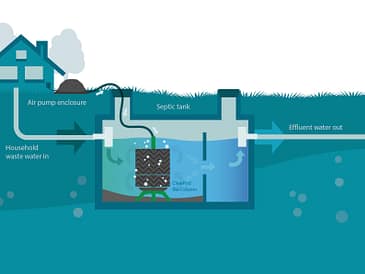Onsite sewage treatment has long been a vital component of maintaining a clean, healthy living environment. However, traditional septic systems have faced their fair share of challenges. Inefficient waste processing, potential environmental hazards, and costly maintenance are just a few of the issues homeowners have encountered over the years. But fear not! The future of onsite sewage treatment holds great promise and is set to revolutionize the way we handle our household waste.
In this detailed article, we will delve into the fascinating world of modern septic tanks and explore how they can address the shortcomings of their predecessors. From advanced technologies harnessing the power of bacteria to eco-friendly solutions that prioritize sustainability, we will uncover exciting innovations that are reshaping the landscape of onsite sewage treatment. Whether you’re a homeowner looking for a greener solution or simply curious about cutting-edge developments in waste management, this article promises to enlighten and inspire.
The Story of Septic Tanks: From Ancient Times to Modern Innovations
Septic tanks have a rich history that stretches back to ancient civilizations. The earliest evidence of basic wastewater treatment comes from the Indus Valley Civilization, where large soak pits were used to filter and purify water. As societies evolved, so did their sewage disposal methods. In ancient Rome, for instance, an extensive network of underground sewers was developed to carry waste away from populated areas.
However, it was not until the late 19th century that septic tanks as we know them today began to emerge. In 1860, the French engineer Jean-Louis Mouras revolutionized sanitation by inventing the first septic tank. This invention marked a turning point in human waste management and laid the foundations for modern onsite sewage treatment systems.
The concept behind septic tanks is simple yet brilliant: they provide a natural way of breaking down organic matter contained in wastewater through a process called anaerobic digestion. These underground chambers separate solid waste from liquids and allow bacteria to decompose organic material without needing oxygen. The effluent produced by this process is then discharged into drain fields or leach fields for further filtration through soil absorption.
Over time, further advancements have been made in the design and functionality of septic tanks. One notable innovation is the development of aerobic systems that introduce oxygen into the tank’s environment, promoting more efficient decomposition and reducing odors associated with traditional anaerobic systems. Additionally, modern septic tanks now incorporate filters and baffles to ensure even higher levels of treatment before effluent exits the system.
Understanding Onsite Sewage Treatment: How Aerobic Septic Systems Work
Aerobic septic systems, also known as aerobic treatment units (ATUs), are a remarkable advancement in onsite sewage treatment. Unlike traditional anaerobic systems, which rely solely on the natural decomposition of waste by anaerobic bacteria, aerobic systems introduce oxygen into the wastewater treatment process.
This additional oxygen allows for the growth and multiplication of aerobic bacteria, which are more efficient in breaking down organic matter and removing contaminants. These aerobic microorganisms thrive in an oxygen-rich environment and play a crucial role in enhancing the efficiency of onsite sewage treatment.
The heart of an aerobic septic system lies in the aerator or air pump. This device continuously introduces air into the wastewater, creating ideal conditions for aerobic bacterial activity. As the wastewater passes through the system’s chambers or compartments, it comes into contact with these thriving bacteria, facilitating further decomposition and purification.
The presence of oxygen in an aerobic septic system not only accelerates waste degradation but also promotes better odor control. By allowing for faster breakdown of organic matter, foul smells associated with traditional anaerobic systems are significantly reduced or even eliminated altogether. This is a great relief to homeowners who not only want effective sewage treatment but also desire a pleasant environment around their homes.
Harnessing the Power of Anaerobic Bacteria: The Key to Effective Waste Treatment
When it comes to onsite sewage treatment, understanding the role of anaerobic bacteria is crucial. These tiny microorganisms play a vital role in breaking down organic matter and converting it into less harmful compounds. Unlike their aerobic counterparts that require oxygen, anaerobic bacteria thrive in oxygen-deprived environments, such as septic tanks, where they contribute to efficient waste treatment.
Within the confines of a modern septic tank system, anaerobic bacteria create an environment conducive to their survival and proliferation. As wastewater enters the tank, these remarkable organisms spring into action. They begin decomposing solid waste through a complex biological process known as anaerobic digestion.
During this digestion process, complex organic molecules are broken down into simpler compounds such as carbon dioxide, methane gas, and water. This transformation not only reduces the volume of waste but also eliminates harmful pathogens present in sewage. Furthermore, by producing biogas (mainly comprising methane), anaerobic bacteria offer an additional advantage: the potential for energy recovery.
The harnessing of anaerobic bacteria’s power in modern septic tanks presents a promising outlook for sustainable waste management solutions. By efficiently breaking down organic matter and promoting pathogen removal, these bacteria contribute significantly to environmental protection and public health preservation. Moreover, with advancements in technology focusing on energy generation from biogas produced during waste treatment processes, we witness a shift towards more self-sufficient systems that can help reduce our reliance on fossil fuels.
The Benefits of Eco-friendly Modern Septic Tanks: A Greener Solution for the Future
As the world becomes increasingly aware of the importance of sustainability, eco-friendly modern septic tanks have emerged as a greener solution for onsite sewage treatment. These innovative systems offer a range of benefits that not only promote environmental conservation but also enhance the well-being of homeowners and their communities.
One significant advantage of eco-friendly modern septic tanks is their ability to efficiently break down waste. By utilizing advanced anaerobic digestion processes, these systems promote the growth and activity of beneficial bacteria. This results in more effective decomposition, minimizing harmful substances released into the environment. With improved waste breakdown, odors are reduced, ensuring a fresher and healthier living environment for homeowners.
Beyond waste treatment efficiency, another important benefit lies in resource conservation. Traditional septic systems can be water-intensive, requiring frequent flushing with large volumes to maintain functionality. In contrast, modern septic tanks utilize innovative technologies such as aerobic processes that allow them to treat wastewater with significantly lower water consumption. This not only reduces strain on local water supplies but also provides long-term cost savings for homeowners through reduced water bills.
Eco-friendly modern septic tanks also play a crucial role in preserving water quality and preventing groundwater contamination. With stringent regulations in place to protect public health and natural ecosystems, these advanced systems ensure that treated wastewater is free from harmful pathogens and chemicals before it infiltrates into the ground or reaches nearby bodies of water. By safeguarding water sources against pollution, these systems contribute to maintaining a healthy ecosystem while offering peace of mind to homeowners regarding their impact on the environment.
Step-by-Step Guide: Installing a Modern Septic Tank for Your Home
In order to install a modern septic tank for your home, it is essential to follow a systematic process that ensures proper installation and optimal functioning. While this task may seem daunting, with the right approach and guidance, you can easily navigate through the steps involved in setting up an efficient and eco-friendly onsite sewage treatment system. Let’s delve into the comprehensive step-by-step guide for installing a modern septic tank.
1. Assess Your Property
The first step is to conduct a thorough assessment of your property to determine the most suitable location for installing the septic tank. Consider factors such as soil composition, topography, and proximity to water bodies. It is also important to comply with local regulations and obtain any necessary permits before proceeding further.
Optimistic spin: Remember that by installing a modern septic tank, you are taking proactive measures towards safeguarding both the environment and your household’s health. You are contributing to cleaner water sources while ensuring efficient waste management within your property.
2. Engage Professional Help
Hiring professional septic system installers is highly recommended for ensuring accuracy and compliance with industry standards. Experienced experts can guide you through the entire process, including site evaluation, designing an appropriate system based on your property’s needs, obtaining requisite permits, excavation work, drainage field preparation, and ultimately installing the septic tank itself.
Optimistic spin: Collaborating with professionals not only guarantees a smooth installation but also provides peace of mind knowing that experts are handling this crucial aspect of your home infrastructure. By entrusting this task to knowledgeable professionals who prioritize quality workmanship, you can focus on other aspects of creating your dream home environment.
3. Excavation and Installation
Once the site has been assessed, excavation work can begin. The area for the septic tank and the drain field will be prepared, ensuring sufficient spacing and proper slope for effective wastewater treatment. The modern septic tank will then be carefully placed into the excavated space, ensuring that all connections are secure.
Optimistic spin: Witnessing your property transform as excavation work unfolds can be both exciting and satisfying. This process symbolizes progress towards a cleaner, more sustainable future where you actively contribute to enhancing the overall well-being of your community.
4. Connecting and Testing
After installation, all necessary connections must be made between the septic tank, plumbing fixtures within your home, and the drain field system. Professional installers will ensure that these connections are watertight, preventing any leakage or contamination risks. Finally, rigorous testing is conducted to verify that the septic system is functioning optimally before it is put into regular use.
Optimistic spin: Congratulations! Your modern septic tank is now installed and ready to efficiently treat wastewater on-site while minimizing environmental impact. By implementing this eco-friendly solution on your property, you have taken a significant step towards creating a greener future for generations to come.
Maintaining Your Septic System: Tips for Longevity and Efficiency
Proper maintenance is essential for ensuring the longevity and optimal performance of your modern septic system. By following a few simple guidelines, you can significantly reduce the risk of costly repairs and environmental damage. Here are some valuable tips to keep your septic system running smoothly.
Regular Pumping
One vital aspect of septic system maintenance is regular pumping. Over time, solid waste accumulates in the tank, reducing its capacity to hold wastewater effectively. To prevent backups and costly repairs, experts recommend scheduling a professional pumping service every two to three years. This process involves removing the accumulated solids from your tank and preventing potential blockages in your system.
By adhering to a regular pumping schedule, you not only extend the lifespan of your septic tank but also ensure that it operates efficiently. Regular pumping prevents excessive strain on the system, reducing the risk of overflow or clogging. Remember, investing in periodic maintenance now can save you significant expenses down the line.
Mindful Water Usage
An essential factor in maintaining a healthy septic system is practicing mindful water usage within your household. Conserving water not only benefits the environment but also helps keep your septic system in prime condition. Avoid excessive water usage by fixing leaky faucets or toilets promptly.
Additionally, be conscious of how much water you use during activities such as showering or laundry. Consider spreading out heavy water usage throughout the day instead of overloading your system at once. By spreading out water-intensive tasks and using appliances efficiently, you help minimize strain on your septic system and promote its longevity.
Avoid Harmful Chemicals
Harmful chemicals present in cleaning products can disrupt microbial activity within your septic tank, leading to imbalances that may affect its performance. To maintain a healthy bacterial environment, it is crucial to avoid using harsh chemicals that can kill off the beneficial bacteria responsible for breaking down waste.
Opt for environmentally friendly cleaning products instead, as they are less likely to harm the bacterial ecosystem in your septic system. By making this small change, you not only protect your septic tank but also contribute to a healthier ecosystem and safer water quality.
Regular Inspections
Regular inspections by licensed professionals are essential for identifying any potential issues before they become major problems. These experts can assess the condition of your septic system, check for leaks or signs of damage, and provide recommendations regarding necessary repairs or maintenance.
Scheduling regular inspections every three to five years can help catch any issues early on and prevent costly repairs or replacements. By investing in routine inspections, you take a proactive approach to ensure the longevity and efficiency of your modern septic system.
The Role of Homeowners in Preserving Water Quality: Responsible Septic System Use
As our society becomes increasingly aware of the importance of environmental conservation, homeowners play a crucial role in preserving water quality through responsible septic system use. By adopting mindful practices, homeowners can contribute to the health and sustainability of their local ecosystems. Here are four key areas where homeowners can make a positive impact:
1. Regular Maintenance and Inspections
To ensure optimal functioning and prevent potential issues, homeowners should adhere to regular maintenance schedules for their septic systems. This includes periodic inspections by professionals to check for any signs of leaks or blockages. By promptly addressing any problems, homeowners can prevent harmful contaminants from seeping into the soil and groundwater.
Furthermore, responsible septic system use involves regular pumping to remove accumulated solids from the tank. This not only maintains proper system function but also prevents potential backups or overflows that could harm nearby water sources.
2. Mindful Water Usage
An essential aspect of responsible septic system use is practicing mindful water conservation in daily activities. Homeowners can reduce strain on their septic systems by being conscious of water usage throughout their household.
Simple habits such as fixing leaky faucets, using low-flow fixtures, and installing water-efficient appliances can significantly minimize water consumption and alleviate stress on the septic system’s processing capabilities. In turn, this helps maintain an optimal balance within the tank and ensures efficient treatment of wastewater before it returns to the environment.
3. Proper Waste Disposal
In order to protect water quality, homeowners must be diligent about proper waste disposal practices when using a septic system. It is crucial to avoid flushing non-biodegradable materials such as wipes, sanitary products, or chemicals that can disrupt the natural decomposition process within the tank.
Implementing a waste management system that segregates non-biodegradable waste from organic matter is highly beneficial. Composting kitchen scraps and yard waste not only reduces the load on your septic system but also provides valuable nutrients for your garden.
4. Education and Awareness
Lastly, homeowners can play an active role in preserving water quality by educating themselves and their communities about responsible septic system use. By spreading awareness of best practices for wastewater management, individuals can empower others to make informed choices that benefit both their own properties and the environment as a whole.
Through community workshops, online resources, or local initiatives, homeowners can promote a culture of environmental stewardship and encourage others to embrace sustainable septic system practices. Together, we can create a collective impact that fosters cleaner water sources for future generations.
Sustainable Practices: Water Conservation and Waste Reduction with Modern Septic Tanks
As we navigate towards a greener future, it is essential to consider sustainable practices when it comes to water conservation and waste reduction. Modern septic tanks provide an excellent opportunity for homeowners to actively contribute to these efforts. By adopting eco-friendly habits and making thoughtful choices, we can significantly minimize our impact on the environment while maintaining efficient onsite sewage treatment systems.
1. Mindful Water Usage:
Conserving water is not only beneficial for the environment but also helps in reducing the strain on your septic system. Implementing simple yet effective measures such as installing low-flow fixtures, repairing leaky faucets promptly, and encouraging shorter showers can make a significant difference. Additionally, considering alternative water sources like rainwater harvesting or graywater recycling systems can further reduce your reliance on freshwater resources.
Did you know?
A single dripping faucet that leaks one drop per second can waste up to 3,000 gallons of water in a year! By taking swift action and fixing such leaks promptly, you not only save precious water but also reduce the strain on your septic system.
2. Conscious Waste Management:
In conjunction with reducing water consumption, conscious waste management practices play a crucial role in optimizing the performance of modern septic tanks. Avoid introducing excessive fats, oils, or harsh chemicals into your system as they can disrupt the delicate balance of bacteria responsible for effective waste breakdown. Instead, opt for environmentally friendly cleaning products and dispose of hazardous materials safely through appropriate channels.
Did you know?
The average household uses approximately 100 gallons of water each day through various activities like washing dishes and doing laundry. By implementing high-efficiency appliances and adopting responsible waste management practices, you can significantly reduce the amount of water and waste that enters your septic tank.
3. Regular Maintenance and Inspection:
Maintaining a well-functioning septic system requires periodic maintenance and inspection. Regularly pumping out your septic tank ensures that solids are properly removed, preventing clogs and potential system failures. Additionally, scheduling professional inspections allows for early detection of any issues or signs of wear and tear, enabling timely repairs to avoid more extensive damage. By investing in preventative care, you promote longevity and efficiency while minimizing the environmental impact.
Did you know?
Regular maintenance not only enhances the lifespan of your septic tank but also helps identify any potential leaks or damages that could contaminate the surrounding soil or groundwater. By addressing these issues promptly, you protect both your property’s value and the environment.
Incorporating sustainable practices into our daily lives is a responsibility we owe to future generations. By embracing water conservation measures, adopting conscious waste management habits, and prioritizing regular maintenance for modern septic tanks, we can contribute positively to the environment while enjoying reliable onsite sewage treatment systems. Together, let us strive towards a future where sustainability is at the forefront of our choices.
Exploring the Future Possibilities: Innovations in Onsite Sewage Treatment
As we venture into the future, the realm of onsite sewage treatment presents a myriad of exciting innovations that promise to revolutionize the way we handle wastewater. Advancements in technology and increased focus on sustainability have paved the way for ingenious solutions that tackle both environmental concerns and public health issues. Let’s delve into some of these groundbreaking possibilities and envision a future where modern septic tanks surpass our current expectations.
The Rise of Smart Septic Systems
With the advent of smart technology, it was only a matter of time before it found its way into onsite sewage treatment systems. Imagine a septic tank equipped with sensors and monitoring devices that continuously analyze waste levels, water quality, and even detect potential malfunctions. These intelligent systems would not only alert homeowners or maintenance professionals when attention is needed but also provide real-time data for optimizing efficiency and reducing water consumption. Such innovation holds great promise in ensuring sustainable waste management practices while minimizing human error.
Harnessing Renewable Energy for Waste Treatment
In our pursuit of a greener tomorrow, innovators are exploring ways to incorporate renewable energy sources into onsite sewage treatment systems. Imagine septic tanks designed with integrated solar panels or small-scale wind turbines that generate electricity to power critical components like pumps or aerators. By harnessing clean energy from nature itself, these innovative solutions not only reduce overall carbon emissions but also ensure self-sufficiency in remote areas without access to traditional power grids.
Microbial Breakthroughs: Enzymes and Biofilms
The world beneath our feet is teeming with microbial life waiting to be harnessed for wastewater treatment purposes. Researchers are tirelessly working on unlocking the potential of enzymes and biofilms – colonies of microorganisms – to enhance the efficiency of septic systems. Imagine a future where specially engineered enzymes break down waste more effectively, reducing the need for frequent pumping and maintenance. Additionally, biofilms that thrive on specific types of contaminants could be introduced into septic tanks to improve the removal of harmful substances from wastewater, resulting in cleaner effluent.
Nanotechnology: The Frontier of Onsite Sewage Treatment
At the forefront of scientific discovery lies nanotechnology, a field with immense potential to revolutionize onsite sewage treatment. Scientists are exploring how nanoparticles can be used to enhance the filter media within septic systems, improving their ability to remove impurities and pollutants. Moreover, nanotechnology offers possibilities for developing self-cleaning membranes that resist clogging and biofilm formation. By incorporating these microscopic wonders into modern septic tanks, we can ensure higher treatment efficiencies while minimizing maintenance requirements.
Taking the Leap: Inspiring Stories of Homeowners Who Embraced Modern Septic Systems
As the world moves towards a more sustainable future, many homeowners have chosen to embrace modern septic systems, not only for their environmental benefits but also for their efficiency and cost-effectiveness. These inspiring stories of homeowners who made the switch to modern septic tanks serve as shining examples of how individuals can make a positive impact on both their personal lives and the planet.
A New Lease on Life: The Smith Family’s Journey
The Smith family had been grappling with frequent septic system failures that caused significant inconvenience and financial strain. Frustrated with outdated technology, they decided to take a leap and install a modern septic tank. The results were remarkable. No longer burdened by constant repairs and maintenance, they now enjoy uninterrupted wastewater treatment. With their new system’s efficient design and improved performance, the Smiths have experienced a renewed sense of tranquility in their home.
Environmental Stewardship at its Finest: Sarah’s Sustainable Lifestyle
Sarah was determined to reduce her ecological footprint and lead a more sustainable lifestyle. Understanding that conventional septic systems contribute to water pollution, she sought an alternative solution. After extensive research, Sarah installed an innovative modern septic tank that utilizes advanced filtration techniques. Today, she takes pride in knowing that her wastewater is being treated responsibly while preserving local water resources for future generations.
A Community United: Jamie’s Neighborhood Initiative
Jamie noticed that many homes in her neighborhood were still relying on outdated septic systems that posed risks to public health and environmental degradation. Determined to catalyze change within her community, Jamie spearheaded an initiative advocating for the adoption of modern septic tanks. Through informative workshops and local outreach efforts, she successfully encouraged numerous homeowners to make the switch. Together, they have transformed their neighborhood into a hub of sustainable wastewater management, fostering a sense of camaraderie and shared responsibility.
Future-Proofing for Generations: The Johnsons’ Forward-Thinking Approach
The Johnson family recognized that investing in a modern septic system was not only an immediate improvement but also an investment in the future. By choosing a system with smart monitoring capabilities and remote access, they have gained peace of mind knowing that any potential issues will be detected and resolved promptly. This forward-thinking approach has not only safeguarded their home but also set an example for their children on the importance of embracing innovative solutions for long-term sustainability.
Conclusion
In conclusion, the future of onsite sewage treatment lies in the realm of modern septic tanks. With advancements in technology and a growing awareness of the need for sustainable solutions, these eco-friendly systems offer a greener and more efficient approach to waste treatment. By harnessing the power of anaerobic bacteria and implementing responsible maintenance practices, homeowners can play a crucial role in preserving water quality and reducing their environmental impact. As we embrace these innovations, we can envision a future where onsite sewage treatment not only meets our needs but also contributes to a healthier planet, leaving us with cleaner waterways and renewed hope for generations to come.





